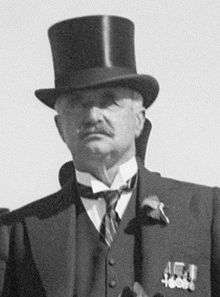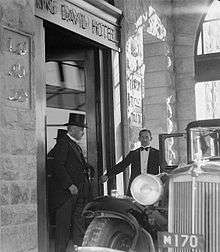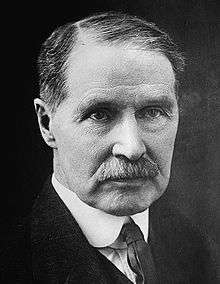William Peel, 1st Earl Peel
| The Right Honourable The Earl Peel GCSI GBE TD PC | |
|---|---|
 | |
| Chancellor of the Duchy of Lancaster | |
|
In office 1 April 1921 – 19 March 1922 | |
| Monarch | George V |
| Prime Minister | David Lloyd George |
| Preceded by | The Earl of Crawford |
| Succeeded by | William Sutherland |
| Secretary of State for India | |
|
In office 19 March 1922 – 22 January 1924 | |
| Monarch | George V |
| Prime Minister |
David Lloyd George Andrew Bonar Law Stanley Baldwin |
| Preceded by | Hon. Edwin Samuel Montagu |
| Succeeded by | The Lord Olivier |
|
In office 18 October 1928 – 4 June 1929 | |
| Monarch | George V |
| Prime Minister | Stanley Baldwin |
| Preceded by | The Earl of Birkenhead |
| Succeeded by | William Wedgwood Benn |
| Personal details | |
| Born |
7 January 1867 London |
| Died |
28 September 1937 (aged 70) East Meon, near Petersfield, Hampshire |
| Nationality | British |
| Political party |
Liberal Unionist Conservative |
| Spouse(s) | Hon. Eleanor Williamson |
| Alma mater | Balliol College, Oxford |

William Robert Wellesley Peel, 1st Earl Peel GCSI GBE TD PC (7 January 1867 – 28 September 1937), styled as Viscount Peel from 1912 to 1929, was a British politician.
Background and education
The eldest son of Arthur Wellesley Peel, 1st Viscount Peel and Adelaide Dugdale, Peel was born in London in 1867. His father was the fifth and youngest son of Prime Minister Sir Robert Peel. He was educated at Harrow and Balliol College, Oxford,[1] where he was secretary of the Oxford Union.[2] In 1893 he was called to the bar at the Inner Temple, and practised as a barrister before taking the position of special correspondent for the Daily Telegraph during the Greco-Turkish War of 1897.[1][2]
Political career
In 1900 Peel was appointed a member of the Royal Commission formed to inquire into the operation of the Port of London. In the same year he began his political career when he was elected to the London County Council.[1] He was a member of the pro-Conservative grouping on the council that became the Municipal Reform Party. He was leader of the Party from 1908 to 1910 and chairman of the county council from 1914 to 1916.[1][2] He had begun his Parliamentary career when he was elected as Liberal Unionist MP for Manchester South at a by-election. At the next general election in 1906 he stood unsuccessfully at Harrow. He returned to the Commons in 1909, when elected as Conservative MP for Taunton at a by-election.[2] He inherited his father's viscountcy in 1912, and moved to the House of Lords.
Peel was appointed a Deputy lieutenant of Bedfordshire[3] and lieutenant-colonel of the Bedfordshire Yeomanry in 1912, and on the outbreak of the First World War moved to France with his regiment. Due to ill health he returned to Britain in 1915. In 1918 he received his first government post as Joint Parliamentary Secretary at the Department of National Service. In 1919 he became Under-Secretary of State for War and a member of the Privy Council.[1][2] Two years later he became Chancellor of the Duchy of Lancaster and Minister for Transport.
He entered the cabinet in 1922 as Secretary of State for India as part of the coalition government of David Lloyd-George but continued in the post after the downfall of the Coalition during the premierships of Bonar Law and Baldwin. Baldwin's Government fell in January 1924, but after a brief spell in opposition was returned to power at the 1924 General Election. Peel was appointed First Commissioner of Works in the Conservative administration formed by Stanley Baldwin. In 1928 he briefly returned to the India Office before the Conservatives lost power at 1929 general election.[2] The latter year he was created Viscount Clanfield, of Clanfield in the County of Southampton, and Earl Peel in the Dissolution Honours.[1] When a Conservative-dominated National Government was formed after the 1931 election he became Lord Privy Seal. He only held this office for two months, leaving government in November.[2]
In 1932 he was appointed chairman of the Wheat Commission, and in 1934 chaired the Royal Commission on the Common Law.[2] In 1936-1937 Lord Peel was the chairman of the Peel Commission which recommended for the first time the partition of the British Mandate of Palestine into separate Jewish and Arab states.[2]
Family
Lord Peel married the Hon. Eleanor, daughter of James Williamson, 1st Baron Ashton, in 1899. They had two children. In 1929 Lord Ashton died and Peel succeeded him as chairman of James Williamson and Company. He was also a director of Barclays Bank and of the Great Northern Railway.[1][2] Lord Peel died aged 70 at his home in East Meon, near Petersfield, Hampshire in 1937 after a long illness.[1][2] He was succeeded in his titles by his son, Arthur.
References
Leigh Rayment's Historical List of MPs
- 1 2 3 4 5 6 7 8 Lord Peel, Family Tradition Of Statesmanship, The Times, September 30, 1937, p. 14
- 1 2 3 4 5 6 7 8 9 10 11 Alex May (2004). "Peel, William Robert Wellesley, first Earl Peel (1867–1937)". Oxford Dictionary of National Biography. Oxford University Press. Retrieved 2008-10-12.
- ↑ The London Gazette: no. 28638. p. 6288. 23 August 1912.
External links
- Hansard 1803–2005: contributions in Parliament by the Earl Peel
